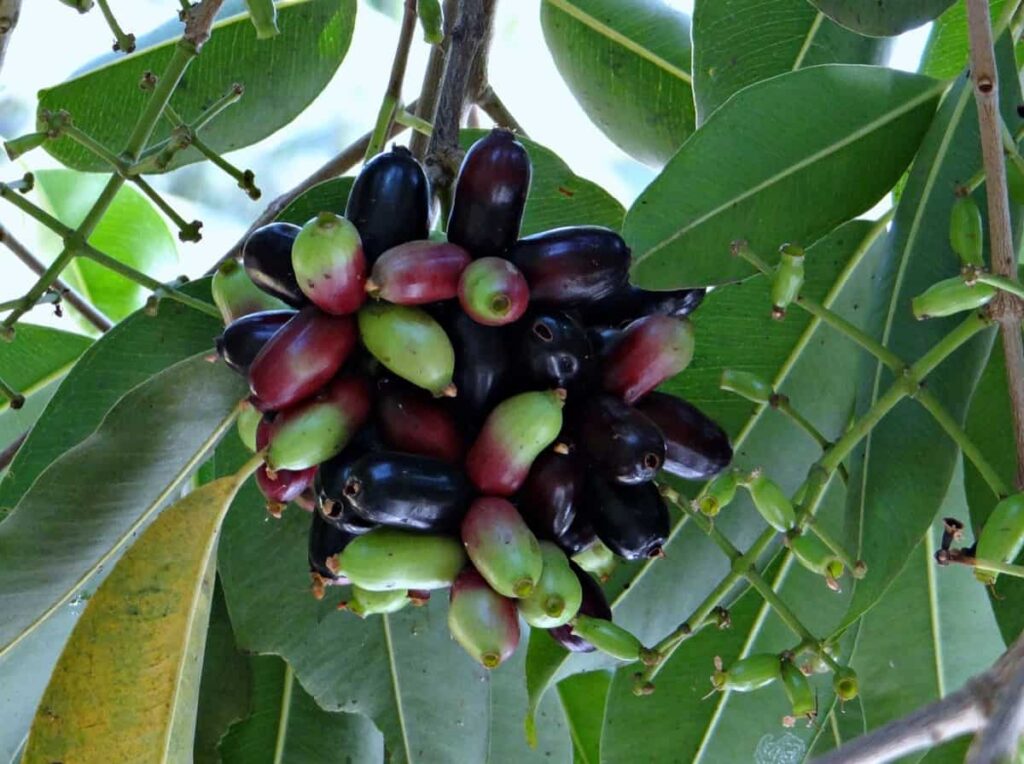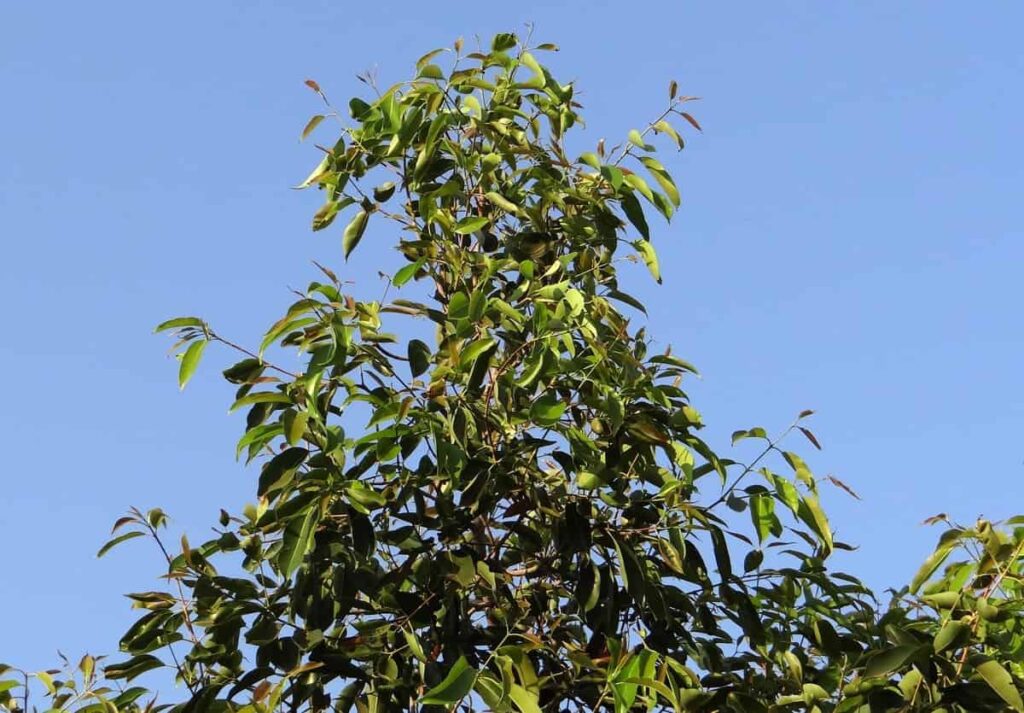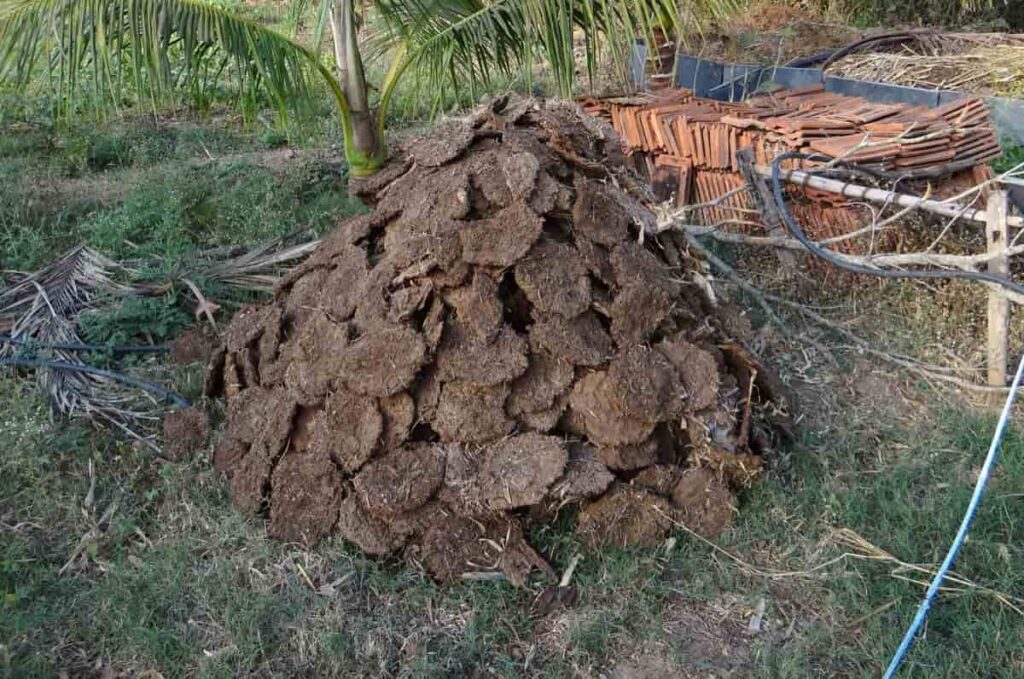The Jamun is a native Indian fruit. A black plum, or java plum, is the name given to these fruits in English. The evergreen Jamun tree can reach a height of 35 feet. They are low-maintenance in terms of water use and cost but provide a relatively low yield per tree. Despite its obvious benefits, many farmers do not favor Jamun growing due to several obstacles.

Below we will learn about Mr. Kondayya’s Jamun farm, the cultivation details of Jamun in Mr. Kondayya’s words, his experiences in growing the plants, and also the investments and profits involved in Jamun cultivation.
Earning 31 lakhs from 9 acre Jamun farm
How to plant Jamun trees?
The Jamun can be spread both vegetatively and via seed. Although the vegetative techniques used in most situations have shown some effectiveness, production from seeds is still favored. However, it is not recommended to grow plants from seeds since this method causes plants to yield their fruit later than usual. No dormancy is present in the seeds. Instead, new seedlings can be planted. In a matter of 10–15 days, the seeds will sprout.
The next year, in the monsoon (August–September) or spring (February–March), seedlings can be transplanted to serve as rootstock. When air layering in the spring, 500 ppm IBA in lanolin paste yields around 60% coverage, but only if the process is avoided during the wet season. For the best results, plant your evergreen Jamun tree in the spring (February–March) or the summer (July–August) months.
Trees planted in February/March endure an extremely hot and dry time in May/June so soon after planting that they often die due to unfavorable weather conditions; the later season is preferred. The land is prepared for planting by being cleaned and plowed thoroughly. One-by-one-meter pits are excavated 10 meters apart in each direction. The digging of pits is often finished before the start of the rainy season. Pits are loaded with 75% topsoil, and 25% composted or well-rotted farmyard manure.
What is the ideal soil for cultivating Jamun plants?
Jamun can be grown in almost any soil. However, it is better to avoid light sandy soil because of the increased risk of tree falls. The trees will grow tall and strong, but their weak roots cause them to topple in high winds. Even though growth is slower in clay soil, it’s still a beneficial soil type to have.
In case you missed it: How to Start Dairy Farming in Cambodia: Key Rules, Business Plan, Breeds, Cost, Profit, License, and Management

Jamun will thrive in any soil type other than those specified above. Adding organic matter to the soil, particularly within a radius of two meters surrounding the plant area, may improve the clay content of the soil. As this would need a great deal of organic matter, compost, or cow dung, it is impractical for commercial production.
How to prepare land for Jamun cultivation?
Although Jamun plants are very hardy, ground preparation in the first few years of their lives may help them develop more quickly and robustly. The soil’s condition is crucial to any planting practice’s success. Before planting the seedlings, prepare a one-meter-square trench by adding three to five kilograms of manure, three to five kilograms of compost, and one kilogram of Neem cake and mixing well.
Maintain a consistent watering schedule and avoid pooling water around the plants. Standard practice in Jamun orchards is for a 10-by-10 meter plot size. High-density planting calls for a 5×5 meter plot size, with 25-meter rows separated from one another.
How to take care of Jamun farm?
About 19 kilograms of fresh wood mulch (FFM) per tree per year is recommended during the beating phase, and 75 kilograms per tree per year is recommended for fruiting trees. Trees tend to put on more vegetative growth in very fertile soils, delaying fruiting. When trees exhibit this behavior, manure and fertilizer shouldn’t be provided to them, and watering should be reduced or stopped in September, October, and February, March.
Facilitates the development of fruit buds, flowering, and fruit sets. 500 kg N, 600g, and 300g K /plant /year should be applied to mature trees. After manuring, it’s best to water the soil. For optimal development, seedlings need to be watered six to eight times. Irrigating fruit trees in September and October encourages healthy fruit bud growth while watering in May and June promotes rapid fruit development. Usually, you’ll want to do around 5–6 irrigations.
In case you missed it: Integrated Pest Management: Principles, Methods, Advantages, Disadvantages and Ideal Management

In the north Indian climate, flowering begins in March and continues until April. When the rains come in June and July or shortly afterward, the fruits are at their peak of ripeness. After blooming, fruit typically matures in three to five months. Fruits go from a bright green to a dark crimson or even a bluish-black. Since this is not a climacteric fruit, it will not mature further once picked. 50-70 kg for fully mature budded trees, and 80-100 kg for seedling trees, are typical annual yields.
Is Jamun farming profitable?
The cultivation of Jamun on one acre of land might net a farmer a potential profit of up to 2 lakh rupees. In India, the states of Maharashtra, Uttar Pradesh, Tamil Nadu, Gujarat, and Assam are the primary producers of Jamun. One acre of land has the potential to produce between six and eight tonnes of the crop when it is farmed using sound agricultural techniques.
How to control pests and diseases in Jamun plants?
Jamun trees often face problems from insects and pests, including whitefly and leaf-eating caterpillars. Due to the height of the trees, conventional agricultural techniques provide a significant challenge when applying insecticides and herbicides. Sprays are made considerably simpler and more possible by high-density farming. Birds and squirrels, rather than insects, are the main predators of Jamun plants.
Plants of the Jamun genus are often visited by crows and other birds, which may result in crop damage. If the leaves of your Jamun tree are spotted or your fruit has water stains, you may have an anthracnose disease. Although anthracnose in Jamun is uncommon, fungicide mix is often used to prevent it.
The success story of Mr. Kondayya
Mr. Kondayya belongs to the Ananthapur district, Andhra Pradesh. He owns 9 acres farm. Previously he used to cultivate different vegetable crops on his land. Due to regular price fluctuations, he wanted to grow long-term crops on his land. He was also looking for crops with little maintenance. He then started looking into various long-term crops which involve good profits. Also, as his land is water scarce, he wanted to select a crop that consumes less water.
In case you missed it: How to Grow Super Napier Grass: A Guide to Planting to Harvesting

He then visited his district agricultural office, and the staff told him to cultivate Jamun plants as they were well suited for his land. When he investigated the crop’s cultivation details, he learned that Jamun’s crop fit his criteria. This crop consumes less water, and it is a long-term crop that will grow for more than 30 years.
He was also amazed by looking at the profit potential of Jamun farm. He then immediately decided to start this venture and gathered his capital. He started Jamun cultivation and now earns huge profits from his Jamun farm. Below we will learn about Mr. Kondayya’s Jamun farm, the cultivation details of Jamun in Mr. Kondayya’s words, his experiences in growing the plants, and the investments and profits involved in Jamun cultivation.
Jamun cultivation details, in Mr. Kondayya’s words
Jamun is a tough fruit that thrives in challenging environments. It does well in both tropical and subtropical climates, says Mr. Kondayya. The season of blooming and fruit setting must be dry. The fruit grows, matures, and ripens more efficiently with early showers. Extreme cold can kill young plants, he added. The best soils are those with a deep loam and good drainage. It is not happy in either extremely dense or very light sand, says Mr. Kondayya. Mr. Kondayya grows his crops in red soil.
He says that he bought his plants from the Chittoor district of AP. He bought his plants for 220 rupees each. He says he chose the Konkan Bahodoli Jamun variety to cultivate on his farm as it yields more. The fruit can grow to a weight of 14 to 16 grams, says Mr. Kondayya. It grows ideally in soils of pH 10.5. He bought 6-month saplings that are wedge grafted. Before buying plants, he checked his plants with their healthy mother plants.
For land preparation, Mr. Kondayya added chicken manure, animal manure, cow manure, neem cake, compost, and castor cake. He then plowed his land thoroughly and made rows at a spacing of 25 between each plant and each row. By utilizing this spacing, he planted nearly 70 plants per acre. Pits should be dug with 1-meter width, 1-meter length, and 1-meter height. Once done, you have to add 1kg super phosphate in the pit and should add manure again and close the pit. After the pit is closed, you must plant the plants.
In case you missed it: Homemade Fertilizer Recipe with Egg Shells: How and When to Apply in the Garden

Once they are planted, you have to water your plants. Mr. Kondayya chose a drip irrigation system for watering his plants and said that this watering system is ideal for cultivating these crops. Drip irrigation involves less water waste and effective watering, which is handy to Mr. Kondayya as his land is scarce. Before watering, the plants should be stacked until they achieve a certain stage.
You have even to add mulching covers on the rows. Mulching covers won’t let any weeds grow near the plant, and they even help maintain water content in the soil. However, these mulching covers should be removed after one year as the plants become trees and roots get established. After 1 and half years, you have to start pruning your plant. This is essential. All the leaves that fall from the tree act as a mulching agent and fertilizing agent for the tree. This reduces much maintenance for the farmer, says Mr. Kondayya.
Pruning should be done very carefully. You shouldn’t let branches grow more than 80 cm. Only two or three strong branches should be selected to grow without pruning them. Pruning is unnecessary every year, but if any disease attacks a branch, you must cut it off. This plant is very less vulnerable to diseases, says Mr. Kondayya. If there are signs of any diseases, one must spray particular insecticides to prevent the disease from growing.
Also, fruitflies, thrips, and aphids are major pests that can be controlled by spraying pesticides. You can start intercropping in your Jamun farm for the first two years, says Mr. Kondayya. He grew tomato crops as intercrops in his 9-acre Jamun farm, says Mr. Kondayya. This helped him a bit in returning his investment. Harvesting starts 5th year after planting. Harvesting should be done very carefully. Harvesting involves much labor, as these fruits should be handpicked from trees. If any fruit falls on the ground, then they are not fit for selling, says Mr. Kondayya.
In case you missed it: How to Identify and Manage Fall Armyworm: Causes, Symptoms, Biological, Chemical, and Integrated Pest Control

Investment and profit analysis, according to Mr. Kondayya
Mr. Kondayya says that it cost him nearly 50,000 rupees per acre. This means for his whole 9-acre farm; it cost him nearly 4.5 acres. Regarding income, he harvests nearly 4 tons of Jamun per acre and sells them at 100 rupees per kg to market. This means he nearly gets 36,00,000 rupees as income from his whole 9-acre farm.
His net profit from Jamun is nearly 31 lakh rupees on average. In this way, Mr. Kondayya earns huge profits from his Jamun farm and is happy and satisfied with what he is doing. He advises farmers to get into long-term crop cultivation as they are easy to maintain, and returns are also very good.
- Crops Grown in Summer Season: Best Choices for Summer Gardening
- Organic Pest Control for Tomato Farming
- How to Maximize Sheep Farming Profit
- Broccoli Varieties: Choosing the Right Cultivars for Your Farm
- How to Raise Pigs in Your Own Backyard: A Comprehensive Guide
- Budget Friendly Sheep Shed Ideas: Cheap and Low-Cost Tips
- How Much Do Cattle Farmers Make: Revenue Streams in Cattle Farming
- Management Pests and Diseases in Your Cotton Field
- Sheep Farming Business Plan for Beginners
- Aquaponic Farming at Home: A Step-By-Step Guide
- Profitable Village Farming Business Ideas in 2024
- High-Yield Aquaculture: Fast-Growing Fish for Farming
- Effective Fish Pond Construction Techniques for Beginners
- Irrigation and Water Management in Pineapple Farming
- Blossom to Harvest: Mastering Flowering and Pollination in Papaya Farming
- Pig Fattening Essentials: From Selection to Sale for Beginners
- Raising Wagyu Cattle: A Complete Guide for Premium Beef Production
- Soil Types and Their Water Holding Capacity
- Optimizing Irrigation Schedules for Coconut Groves for Enhanced Yield
- Espresso Your Garden: Coffee Grounds for Healthier Acid-Loving Plants
- The Best Soil Mix for Snake Plants: How to Mix Your Own Snake Plant Soil
- Green Thumb Success: Expert Tips for Cultivating Greenhouse Beans All Year Round
- Bloom All Year Round: The Ultimate Guide to Indoor Hyacinth Care
- Eco-Friendly Gardening: How to Make Liquid Fertilizer from Kitchen Waste
- Ultimate Guide to Grow Anise in Pots: Explore Seed Propagation to Harvesting
- Guide to Raising Chester White Pigs: Discover Breed Facts to Growth Management
- Mastering the Elegance: The Ultimate Guide to Weeping Cherry Tree Care, Planting, and Maintenance
- Ultimate Guide to Planting Garlic in Grow Bags: Growing Strategies for Beginners
- How to Fix Spider Plant Leaf-Related Problems: Natural and Organic Remedies
- 10 Reasons Why Your Tulsi Plant is Shedding Leaves: Home Remedies and Solutions
- Optimizing Growth and Yield: The Advantages of Palm Bunch Ash Fertilizer
- Utilizing Neem Oil Extract as a Natural Pesticide for Hydrangea
- From Soil to Harvest: Various Ways in Which Farmers Can Use AI Tools
- Steps to Encourage and Induce Citrus Flowers: A Comprehensive Guide
- How to Fix Snake Plant Leaf-Related Issues: Natural and Organic Remedies
- Transform Your Garden into a Fragrant Oasis with Raat Ki Rani (Night Blooming Jasmine)
